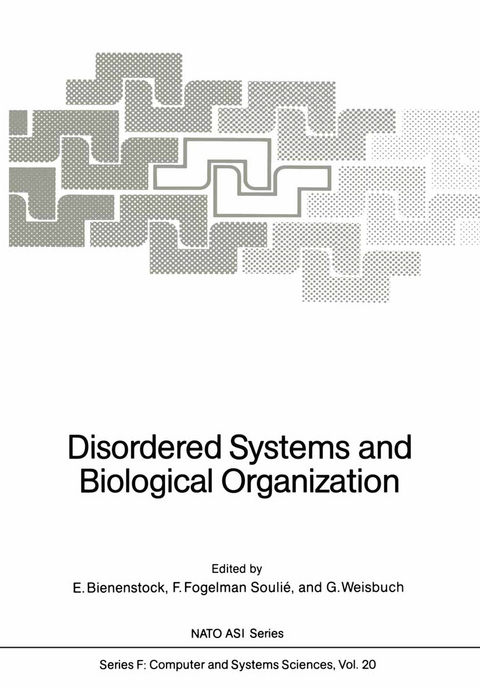
Disordered Systems and Biological Organization
Springer Berlin (Verlag)
978-3-642-82659-7 (ISBN)
1-Automata Theory.- 1 Cellular automata models of disorder and organization.- 2 Dynamics and Self organization in one-dimensional arrays.- 3 Basic results for the behaviour of discrete iterations.- 4 On some dynamical properties of monotone networks.- 5 Inhomogeneous cellular automata (INCA).- 6 The Ising model and the Rudin Shapiro sequence.- 7 Dynamical properties of an automaton with memory.- 8 Dynamics of random boolean networks.- 9 Random fields and spatial renewal potentials.- 10 Lyapunov functions and their use in automata networks.- 11 Positive automata networks.- 12 Directional entropies of cellular automaton-maps.- 2- Physical Disordered Systems.- 13 On the statistical physics of spin glasses.- 14 Symbolic computation methods for some spin glasses problems.- 15 Order and defects in geometrically frustrated systems.- 3- Formal Neural Networks.- 16 Collective computation with continuous variables.- 17 Collective properties of neural networks.- 18 Determining the dynamic landscape of Hopfield networks.- 19 High resolution micro-fabrication and neural networks.- 20 Ultrametricity, Hopfield model and all that.- 21 The emergence of hierarchical data structures in parallel computation.- 22 Cognitive capabilities of a parallel system.- 23 Neural network design for efficient information retrieval.- 24 Learning process in an asymmetric threshold network.- 25 Layered networks for unsupervised learning.- 26 Statistical coding and short-term synaptic plasticity: a scheme for knowledge representation in the brain.- 27 A physiological neural network as an autoassociative memory.- 4- Combinatorial Optimization.- 28 Configuration space analysis for optimization problems.- 29 Statistical mechanics: a general approach to combinatorial optimization.- 30 Bayesian image analysis.-31 The Langevin equation as a global minimization algorithm.- 32 Spin glass and pseudo boolean optimization.- 33 Local versus global minima, hysteresis, multiple meanings.- 5- Models of Biological Organization.- 34 Boolean systems, adaptive automata, evolution.- 35 Invariant cycles in the random mapping of n integers onto themselves. Comparison with Kauffman binary network.- 36 Fibroblasts, morphogenesis and cellular automata.- 37 Percolation and frustration in neural networks.- 38 Self organizing mathematical models: non linear evolution equations with a convolution term.- 39 Recurrent collateral inhibition simulated in a simple neuronal automata assembly.- 40 Cerebellum models: an interpretation of some features.
| Erscheint lt. Verlag | 15.12.2011 |
|---|---|
| Reihe/Serie | NATO ASI Subseries F: |
| Zusatzinfo | XXI, 405 p. |
| Verlagsort | Berlin |
| Sprache | englisch |
| Maße | 170 x 244 mm |
| Gewicht | 740 g |
| Themenwelt | Informatik ► Theorie / Studium ► Künstliche Intelligenz / Robotik |
| Informatik ► Weitere Themen ► Bioinformatik | |
| Technik | |
| Schlagworte | Automata • combinatorial optimization • Computer Science • learning • Mathematics • Modeling • Mutation • Optimization |
| ISBN-10 | 3-642-82659-8 / 3642826598 |
| ISBN-13 | 978-3-642-82659-7 / 9783642826597 |
| Zustand | Neuware |
| Haben Sie eine Frage zum Produkt? |
aus dem Bereich


